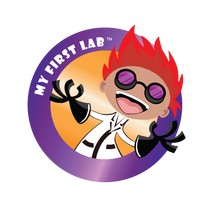
Fun STEM Snow Day Activities
Fun STEM Snow Day Activities
Do you and your kids need some fun activities for the next time you're stuck inside with nothing else to do? My First Lab has just what you're looking for! Here are some fun activities you can try with your kids the next time school is canceled to make an at-home learning experience fun!
Blow Bubbles
Blowing bubbles with your kids when the temperature is below 15 degrees Fahrenheit is a great way to teach kids about the freezing points of different materials! While the freezing point of water is 32 degrees Fahrenheit, the freezing point of soap is about 12 degrees Fahrenheit. The middle layer freezes when you blow bubbles at this temperature and creates a beautiful shimmery frozen orb.
Try Catching Snowflakes
Catching snowflakes can be an excellent way for your kids to examine something new at a microscopic level! You can find the tools your kids will need to look at snowflakes up close on our My First Lab website. A kid-safe microscope that could work well for this type of investigation is our MFL Duo Scope Starter Kit. Another great option for looking at snowflakes closely while on the go is our Smartphone Inspector. For catching the snowflakes, it may be best to use a sturdy piece of black construction paper.
Build a Snow Fort or Snowman
Building a snow fort is a unique way to teach your kids about snow's density and physical properties. Building a snow fort is best suited for older kids, as it might be a bit complex for younger children. A snowman may be the best choice for younger kids. This project will allow kids to see the difference in density between packed old snow and freshly fallen snow. This activity is a fun entryway for older kids to discuss the properties of water and how it freezes.
Wet snow is considered heavy, packed snow after falling because it has more liquid and freezes with a higher density of water in the flakes. Dry snow, in contrast, has less liquid in the snowflakes that fall, making it easier to remove or move. Teaching your kids the difference between dry and wet snow can be great for learning about science and for learning potential survival skills for extreme temperatures.
Create Ice Insulation
Let your kids take different materials from around the house to see which is best used to keep ice from melting! You can take a reusable plastic container and ask your kids to line it with various fabrics and use tape on the sides to keep it in place. This project allows your kids to review the insulating properties of different linings and determine which works best.
Try Melting Ice with Different Substances
Salt is usually used to melt ice. With this experiment, you can show your child how different substances can melt ice. Take each piece of ice and set it in a muffin baking tray. After this is complete, add the same amount of hot water, sugar, salt, and cold water to each muffin tin. Leave one ice unattended as a control. See which ice melts first and discuss why certain substances melt ice faster than others!
How do these substances melt ice? Salt dissolves ice by adhering to the water layer surrounding the ice, and as it does so, it lowers the freezing point, causing the ice to melt. Whether cold or hot, water melts ice due to having a higher temperature than the ice. Sugar lowers the freezing point by creating more space between water molecules.
Our products can help you create an at-home learning laboratory that can keep your kids entertained in any weather! Whether investigating plants, snow, or any other natural feature, MFL is sure to have what you need to optimize your at-home learning experience. We are excited to bring you the best products for STEM kids learning. Check out our Maximum Launch page for more fun experiments!
My First Lab has been a leader in developing STEM equipment for the past 30 years. With products ranging from microscopes and bundles to prepared slides and accessories, we are sure to have any product that a junior investigator, hobbyist, or educational leader could need. Learn how to create hands-on experiments by browsing our blog or checking out our award-winning products.





